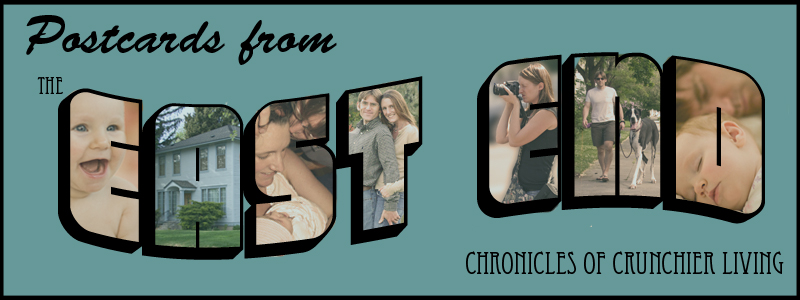
Having determined that we wanted to feed Violet organic food as much as possible, we were presented with the question of the best place to obtain it. We're fortunate in that we have several options where we live, including the local Co-op and the Saturday Farmer's Market, as well as the standard grocery store. But, we thought, why not grow as much of it ourselves as we can, and just shop to fill in the gaps? Maybe because with an infant and trying to get a new business off the ground, we didn't need to take on one more project. But we did it anyway.
The garden was something of an impulse this year, so at the end of March when we began working on it, we were scrambling. To start things off, we pulled up the sod in the strip in front of and on the east side of the garage, and tilled the ground there. Eric built 4 garden boxes to fit the space: two 2 x 8 boxes, one 4 x 12, and a 3 x 3 x 3 x 8 trapezoid to fill the half circle already curbed in front. We also purchased and assembled a fifth box that came with a frame to support a greenhouse cover or shade cover.
 We filled each of the beds with composted soil we had delivered, and Eric rigged up an intricate irrigation system of drip hoses that allows us to water each bed individually. Although April in Boise is too cold to plant most crops, the greenhouse bed gave us the opportunity to get a few things going. We planted some salad basics there (spinach, lettuce, mixed greens, and carrots) as well as cilantro, and tomato and pepper seeds we planned to move once they were started.
We filled each of the beds with composted soil we had delivered, and Eric rigged up an intricate irrigation system of drip hoses that allows us to water each bed individually. Although April in Boise is too cold to plant most crops, the greenhouse bed gave us the opportunity to get a few things going. We planted some salad basics there (spinach, lettuce, mixed greens, and carrots) as well as cilantro, and tomato and pepper seeds we planned to move once they were started.
That done, we moved on the the section of the yard along the back fence, which happened to be occupied by a beautiful (cough, cough) water feature that never served any purpose other than to cultivate a rich bed of algae each summer. Tearing that out was quite a task - I even got to swing a sledgehammer for the first time. Once we cleared the space, Eric built another 5 beds: four 2 x 12 beds and one 1 x 5 for herbs.

Planting took place throughout this process, as some crops (like spinach, lettuce and other greens) could withstand colder temperatures. Even Violet participated, and everything was in by mid-May: peas, beans, onions, celery, carrots, potatoes, spinach, lettuce, arugula, mixed greens, tomatoes, tomatillos, peppers (hot and sweet, and lots of them), yellow squash, zucchini, scallop squash, cucumber, butternut squash, sweetmeat squash, black futsu squash, Melonette Jaspee De Vendee squash, corn, raspberries, blackberries, marionberries and tayberries.


As of this past weekend, the peas, potatoes and onions are thriving, carrots and celery appear to be progressing, and corn and squash are starting to pop up. Tomatoes have been transplanted, and the bare spots in the two weed-ravaged beds replanted with quicker-growing greens. About a week ago, we were able to cut our first homegrown salads! As for the rest of the crops, we'll have to wait a while. And weed . . .






